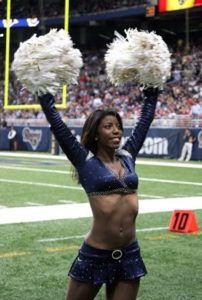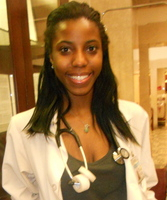Recently, Amanda (a former cheerleader for the St. Louis Rams) won an award for her work in breast cancer research, from the Journal of the American Society of Clinical Oncology. We caught up with her during her medical school studies at Columbia University. During the interview, she offered to answer any questions you might have about the med school application process. More on that in a moment. First, let’s get to know our newest Science Cheerleader. (Updated 12/16/13)

SciCheer: Amanda, please tell us when/how you first became interested in science.
Amanda: I have had an interest in science as long as I can remember.
SciCheer: Amanda, please tell us when/how you first became interested in science.
Amanda: I have had an interest in science as long as I can remember.
SciCheer: What do you do for a living?
Amanda: I am a doctor. First, I graduated from Washington University in St. Louis with a Bachelor of Arts in Classics and in Biology. In 2012 I graduated with a medical degree from Columbia University- College of Physicians and Surgeons. I am currently a second year resident in Obstetrics and Gynecology and Columbia/New York Presbyterian Hospital.
SciCheer: Good for you! Which team did you cheer for and when?
Amanda: St. Louis Rams- 2006-2008
SciCheer: Which came first: your interest in cheerleading or your interest in science?
Amanda: Interest in science.
SciCheer: Do you feel your work as a professional cheerleader helped or hindered your career?
Amanda: Cheerleading absolutely helped my career. Science and medicine are fields that require teamwork as well as the ability to learn quickly. These skills are also essential to being a successful cheerleader.
SciCheer: Do you have any advice for youngsters who might feel torn between following one dream (often associated with beauty or sportiness) and pursuing a science and engineering career (too often associated with geeks)?
Amanda: Beauty comes in all shapes, forms and colors and most importantly it comes from within each of us. I don’t recall ever reading a rule that beauty had to be limited to one particular type of person or that it had to exclude people that love learning. Sometimes the media perpetuates these messages about “beauty,” “jocks,” and “geeks” but in real life, people don’t come with labels but rather their own experiences, strengths and weakness that make her special. There are no rules; find out what it is that fulfills you and if that’s setting up experiments in the morning and shaking your pompoms at night then do it!
SciCheer: How did your fellow cheerleaders accept your interest in science?
Amanda: I came from a particularly brainy squad (the St. Louis Rams cheerleaders). We had a certified public accountant as well as cheerleaders with degrees in graphic design and computer science and yet another cheerleader pursing a degree in psychology. Practice generally focused on learning routines but when we did have time to hang out, my interest in science was celebrated.
SciCheer: Is there advice you would give your former 10-12-year-old self, now that you have the benefit of hindsight?
Amanda: Ask mom and dad for more dance lessons! I grew up playing soccer and participating in science enrichment classes however I always wanted to dance but did not speak up. Luckily in high school, I joined a dance team that took new dancers without experience; this is where I learned the majority of my technique. However, as a professional cheerleader I always felt that I needed to practice more than my colleagues to keep up with the routines and wished I had had a better foundation in ballet.
 SciCheer: Can you describe a “typical day” at work?
SciCheer: Can you describe a “typical day” at work?
Amanda: What I love most about my job is that rarely are two days the same. Generally speaking, I will see patients in the morning after their surgery or after they have delivered their baby. I will make sure that they feel well and are healing appropriately. I then discuss the patients with a whole team of doctors and we make plans for the day about our patients, perhaps they need imaging, a new medication, laboratory tests or maybe they are doing well enough to go home. Next, I am either in the operating room doing cesarean sections, removing fibroids or endometriosis, even cancers. Sometimes I am on the labor floor delivering babies. Otherwise, I will see patients in clinic working with women that are pregnant or with general women’s issues.
SciCheer: What would most people find surprising about your field of interest?
Amanda: Most people are surprised at how long it takes to become a fully trained doctor. It takes 4 years of college to receive a bachelor’s degree and 4 years of medical school to receive a medical degree and become a doctor. I am now completing my 4 years of postgraduate training to become a specialized doctor in obstetrics and gynecology. You have to really love what you do to be committed to the path of becoming a doctor.
SciCheer: Best cheerleading experience?
Amanda: My two favorite memories are cheering in the player tunnel with fireworks in the background at beginning of a home game and performing for the troops in South Korea.
SciCheer: Favorite and least favorite courses you took to prepare for your work?
Amanda: Favorite courses: Human Genetics, Human Physiology, Clinical Practice, and Neurology. Least favorite courses: General chemistry and Physics.
SciCheer: More exhilarating: positive experimental results or nailing a cheer move?
Amanda: Definitely positive experimental results
SciCheer:Anything else you’d like readers to know?
Amanda: If you have any questions about medical school or life as a doctor please do not hesitate to contact me through science cheerleader.
Thanks, Amanda! We’re happy to have you on the squad!

